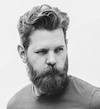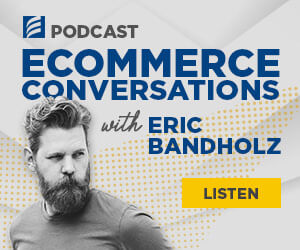Nate Lagos is vice president of marketing for Original Grain, a direct-to-consumer watch maker. He relies on Facebook advertising, but not for immediate customer acquisition.
“Platforms such as Facebook are megaphones, not salespeople,” he says.
In our recent conversation, Nate shared his marketing origins, advertising tactics, influencer management, and more.
Our entire audio conversation is embedded below. The transcript is edited for length and clarity.
Eric Bandholz: Give us a quick rundown of who you are and what you do.
Nate Lagos: I’m the vice president of marketing at Original Grain, a watch company that blends wood and steel to create timepieces that guys want to wear. I’ve been here four years, leading growth through product innovation and creative marketing campaigns. Before that, I served as CMO for a couple of smaller ecommerce brands.
The last four years at OG have been exciting, fast-paced, and at times stressful — but extremely rewarding.
My marketing journey started in college. I fell in love with the subject after my first class, but quickly realized school wouldn’t teach me how to thrive in the real world. I had one great professor, but most classes fell short. I began freelancing during my sophomore year, running organic and paid social campaigns for local businesses, and built from there.
I host a twice-weekly podcast called “Tactical & Practical.” Each episode is 10-12 minutes and delves into a single tactic we’re using or a challenge I’m facing. The goal is to create the kind of honest, tactical content I wish I had at my first CMO job at age 24, when I had no idea what I was doing.
Bandholz: How do you approach media buying and ad strategy?
Lagos: I see advertising as a way to amplify great brands, not as a tool to acquire customers directly. Platforms such as Facebook are megaphones, not salespeople. I pour budget into that megaphone because impressions have long-term value, even if they don’t immediately convert.
Nearly all of our ad budget goes to Facebook, primarily for conversion campaigns. Our average order value for new customers is $360. Their buying decisions often take months. So, we don’t obsess over daily customer acquisition costs — we focus on consistent awareness and brand affinity that pays off during key moments, such as the holidays.
Our performance metric is straightforward: If we spend $10,000 promoting a watch and earn $40,000 from it, the ads are effective, regardless of Facebook’s internal metrics. If we only make $11,000, we cut spend, test new creative, or shift messaging.
We typically advertise our top five watches, not our entire catalog. We structure our campaigns by collection, and we measure success both at the individual product level and the collection-level return-on-ad-spend. Meta accounts for 95% of our spend. The rest goes to Google, YouTube, and influencers, which we’d like to grow, though they’re harder to scale and produce content for.
Bandholz: What’s your strategy for changing ad creative on Meta?
Lagos: I’m still figuring that out. Historically, we didn’t launch a large number of ads — typically around 10–15 per week — even as we grew by over 100% last year from an eight-figure base. This year, we’ve ramped that up to 30–40 ads weekly. It’s not because we need more volume to find winners, but because Facebook won’t allocate spend unless we launch more.
The platform tends to push our top-performing ads, which is fine until those ads plateau. Previously, we could introduce new creative into the same ad set, and Facebook would distribute spend. That’s no longer happening. By increasing volume, we’re now seeing new ads spend faster and find winners more quickly.
Our full-time photographer is also our creative inspiration, handling graphic design and brand direction. We hired an operations lead earlier this year. He focuses on Klaviyo and Postscript scheduling and helps out with social and influencer campaigns. So there are three of us on the team.
Most of our messaging angles come from copy I test directly on our site. Once we see what converts there, we repurpose that language into ads.
Bandholz: Thirty pieces of content weekly takes work.
Lagos: Approximately one-third of our content consists of iterations of past winners — duplicate headlines, graphics, and photography styles. If a creative is performing, we replicate it across our top five watches and underperformers we want to push.
For new content, Chris (our creative lead) and I brainstorm weekly using a shared Canva board. I lean toward old-school inspiration — vintage Rolex and cigarette ads — while he pulls modern ecommerce and consumer-focused examples. We compare notes on what we like and dislike, and adapt our messaging and offers to those styles.
We’re intentional with testing. If we’re trying a new visual format, we’ll pair it with a proven offer, headline, and watch. If it flops, we know it’s the visual that didn’t land, not the copy or the product. It helps us stay efficient and avoid confusion when something doesn’t work.
Bandholz: What makes your top product so successful?
Lagos: We launched our top-selling watch two years ago. It’s an automatic skeleton-dial watch, so you see all the inner mechanics. It’s black-plated stainless steel with charred whiskey barrel wood, and that combo crushes. Since then, we’ve launched other watches using similar elements, and many have worked. Our founders do an incredible job designing them.
I’ve learned it’s not the marketing that determines success. We launched this watch with the same email, ad, and strategy as others. So when one sells out and the other doesn’t, no one blames marketing — it’s all about product-market fit.
Keeping this watch in stock has been the real challenge. We launched 400 units in November 2023, and they sold out quickly. We thought it was holiday timing, but it continued to sell — 500 more, then thousands for Father’s Day, and then a massive run in Q4 2024. Eventually, I raised prices and pulled back ads to slow sales.
Bandholz: You mentioned influencers. What’s your strategy?
Lagos: We’re lucky because we’re our own target audience — 35 to 50-year-old guys who drink whiskey and love outdoorsy, rugged stuff. So we’re already fans of the people we end up working with. We also survey our customers about their music and sports preferences to guide our influencer selection.
Our outreach is mostly manual. We send cold direct messages, and I occasionally reach out to agents on LinkedIn. Having big-name partners such as Jack Daniel’s and Taylor Guitars gives us instant credibility. Influencers take us seriously when they see who we work with.
We don’t do affiliate or revenue share. It doesn’t align with our long purchase cycles. Instead, we pay a flat fee for a set number of posts or YouTube inclusions. Instagram collaborations let us repurpose posts as ads. They aren’t high converters but deliver great impression and click costs.
We use codes and links to track YouTube performance and calculate revenue per thousand impressions. Some audiences, such as whiskey content creators, bring $80 RPMs, while lifestyle comedians bring $20. As long as we pay below those amounts, the channel works. We’ve also had success with truck, outdoors, and even music creators, although music has been hit or miss.
Bandholz: Where can people buy your watches and reach out?
Lagos: OriginalGrain.com. I’m on X and LinkedIn. My podcast is Tactical & Practical.





